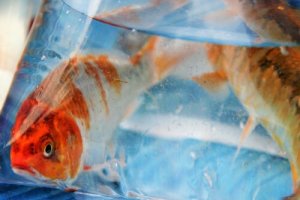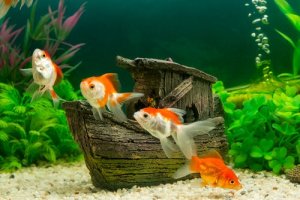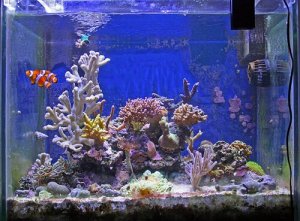Setting Up an Aquarium for the First Time


Written and verified by the lawyer Francisco María García
Setting up an aquarium for the first time doesn’t just mean pouring a load of water and gravel into a tank and then releasing your fish into the water. In reality, the initial process can be a lot slower than many people might think.
This isn’t something you can do in just one day. If you want your fish to acclimatize to their new home and go on to live long, healthy lives, you’ll need to take a longer, but far safer route when preparing your tank.
So, in this article, we want to show you how to set up your aquarium for the first time, and how to avoid some of the most common mistakes.
First the aquarium, then the fish
Many people make the mistake of thinking that you buy the pet first, and then start to create the right environment for them. While this might work with dogs, aquatic animals are very different. In fact, the process of filling, acclimatizing and stabilizing the tank can take several weeks, if it’s done properly.

The first step is to rinse your aquarium with water to remove any dust or dirt. Then, you can line the bottom of the tank with the gravel substrate.
The next step is to start filling your aquarium with water. However, you’re still a long way away from being able to introduce your fish to their new home.
The water
To start with, you can fill it directly from a hose or faucet. The best thing to do is use cold or natural water, as it comes straight from the pipes. We wouldn’t recommend using water that passes through your boiler, as it may contain contaminants.
Next, use a heater thermostat to heat the water to the right temperature, and install your filter. Although you should never introduce your fish straight away anyway, it’s good to bear in mind that some tropical species can only live in water that’s 73 – 79 °F.
The next step is to follow a set of procedures in order to regulate the quality of the water. Fish that live in a carefully controlled and balanced aquarium will have a far greater life expectancy.
Setting up an aquarium for the first time: de-chlorinating the water
It’s always a good idea to buy water conditioner, which can remove chlorine from the water. Remember, the water we drink is treated with chlorine, with the aim of removing contaminants and making it safe for human consumption. For fish, however, chlorine is toxic.
When we use products that remove chlorine from the water, we also remove any chloramines and heavy metals that might be present. Meanwhile, the ecosystem will continue to stabilize, until it’s suitable for your new pets.
Setting up an aquarium for your fish can take anywhere between 4 and 6 weeks. The more time you take to prepare your tank, the better the environment will be for your fish.
Cycling your fish tank
Having a clean fish tank isn’t the same as having a spotlessly clean kitchen. For it to be habitable for your fish, it must have a colony of nitrifying microbes that can process all the toxic waste that naturally occurs in this kind of environment.
You’ll need to wait several weeks to allow the first colony of protective and purifying microorganisms to form. Over the first few days, ammonia will appear, which is why it’s best not to introduce your fish too quickly.
However, after the third or fourth week, nitric oxide will form, which is responsible for oxidizing ammonia. When this happens, the tank will be all but ready, and you can start to introduce your fish. To help the process along, you can also add natural plants, and sprinkle small quantities of fish food into the tank early on.

Measuring instruments
The best way to make sure you set up your tank properly is to measure everything carefully. Once you’ve filled the aquarium for the first time and left it to cycle for a few days, we’d recommend using specialist tests to check the toxicity levels of the water.
You should be able to buy tests to measure the levels of nitrate, nitrite and ammonia in your aquarium from your local pet store. They’re really easy to use.
It may also be useful to measure the pH. Here, it’s important to know which species of fish you’re going to buy, and to study the optimal conditions for that particular animal.
Setting up an aquarium for the first time doesn’t just mean pouring a load of water and gravel into a tank and then releasing your fish into the water. In reality, the initial process can be a lot slower than many people might think.
This isn’t something you can do in just one day. If you want your fish to acclimatize to their new home and go on to live long, healthy lives, you’ll need to take a longer, but far safer route when preparing your tank.
So, in this article, we want to show you how to set up your aquarium for the first time, and how to avoid some of the most common mistakes.
First the aquarium, then the fish
Many people make the mistake of thinking that you buy the pet first, and then start to create the right environment for them. While this might work with dogs, aquatic animals are very different. In fact, the process of filling, acclimatizing and stabilizing the tank can take several weeks, if it’s done properly.

The first step is to rinse your aquarium with water to remove any dust or dirt. Then, you can line the bottom of the tank with the gravel substrate.
The next step is to start filling your aquarium with water. However, you’re still a long way away from being able to introduce your fish to their new home.
The water
To start with, you can fill it directly from a hose or faucet. The best thing to do is use cold or natural water, as it comes straight from the pipes. We wouldn’t recommend using water that passes through your boiler, as it may contain contaminants.
Next, use a heater thermostat to heat the water to the right temperature, and install your filter. Although you should never introduce your fish straight away anyway, it’s good to bear in mind that some tropical species can only live in water that’s 73 – 79 °F.
The next step is to follow a set of procedures in order to regulate the quality of the water. Fish that live in a carefully controlled and balanced aquarium will have a far greater life expectancy.
Setting up an aquarium for the first time: de-chlorinating the water
It’s always a good idea to buy water conditioner, which can remove chlorine from the water. Remember, the water we drink is treated with chlorine, with the aim of removing contaminants and making it safe for human consumption. For fish, however, chlorine is toxic.
When we use products that remove chlorine from the water, we also remove any chloramines and heavy metals that might be present. Meanwhile, the ecosystem will continue to stabilize, until it’s suitable for your new pets.
Setting up an aquarium for your fish can take anywhere between 4 and 6 weeks. The more time you take to prepare your tank, the better the environment will be for your fish.
Cycling your fish tank
Having a clean fish tank isn’t the same as having a spotlessly clean kitchen. For it to be habitable for your fish, it must have a colony of nitrifying microbes that can process all the toxic waste that naturally occurs in this kind of environment.
You’ll need to wait several weeks to allow the first colony of protective and purifying microorganisms to form. Over the first few days, ammonia will appear, which is why it’s best not to introduce your fish too quickly.
However, after the third or fourth week, nitric oxide will form, which is responsible for oxidizing ammonia. When this happens, the tank will be all but ready, and you can start to introduce your fish. To help the process along, you can also add natural plants, and sprinkle small quantities of fish food into the tank early on.

Measuring instruments
The best way to make sure you set up your tank properly is to measure everything carefully. Once you’ve filled the aquarium for the first time and left it to cycle for a few days, we’d recommend using specialist tests to check the toxicity levels of the water.
You should be able to buy tests to measure the levels of nitrate, nitrite and ammonia in your aquarium from your local pet store. They’re really easy to use.
It may also be useful to measure the pH. Here, it’s important to know which species of fish you’re going to buy, and to study the optimal conditions for that particular animal.
All cited sources were thoroughly reviewed by our team to ensure their quality, reliability, currency, and validity. The bibliography of this article was considered reliable and of academic or scientific accuracy.
- Rojas Hancco, J. P. (2019). Determinación de la eficiencia de las bacterias nitrosomonas y nitrobacter para remover concentraciones de amonio, ion nitrito e ion nitrato en agua del río Torococha a distintos niveles de pH y temperatura, 2018. (Tesis de grado, Universidad Peruana Unión)
This text is provided for informational purposes only and does not replace consultation with a professional. If in doubt, consult your specialist.








